Bedload Velocity and Backscattering Strength from Mobile Sediment Bed: A Laboratory Investigation Comparing Bistatic Versus Monostatic Acoustic Configuration
Abstract
1. Introduction
2. Methodology
2.1. Experimental Set-Ups
2.1.1. NTNU Flume: Monostatic Acoustic System
2.1.2. UniBo Flume: Bistatic Acoustic System
2.2. Acoustic Theory
2.2.1. Basic Principles
2.2.2. Monostatic Sonars
2.2.3. Bistatic Sonars
2.2.4. Echo Intensity (EI)
2.3. Data Postprocessing
2.3.1. ADCP Data Postprocessing
2.3.2. Detection of the Immobile Bed and the Cells Containing Bedload Velocities (Ubertone Instruments)
2.3.3. UVP Data Postprocessing
2.3.4. ADVP Data Postprocessing
2.3.5. Imaging Data Postprocessing
3. Results
3.1. Apparent Bedload Velocities—UniBo Experiments (ADVP vs. ADCP)
3.2. Apparent Bedload Velocities—NTNU Experiments (UVP vs. ADCP)
3.3. Deviation in the Bedload Velocity Estimation: UniBo Experiments (ADVP vs. ADCP)
3.4. Deviation in the Bedload Velocity Estimation—NTNU Experiments (UVP vs. ADCP)
3.5. Echo Intensity: UniBo Experiments
3.6. Echo Intensity: NTNU Experiments
4. Discussion
4.1. Apparent Bedload Velocity
4.2. Echo Intensity
5. Conclusions
- A finer cell resolution and the possibility of profiling the bedload velocities.
- The possibility of detecting the thickness of the active bedload layer.
- Easier characterization of the backscattering sources, e.g., the influence of the immobile surface irregularity, isolating the surface from volume scattering.
- More focused beams, i.e., a smaller beam opening angle, φ, should lead to a more superficial sampling of the bedload. This implied that for a given frequency, a larger transducer should return more realistic data in the absence of water bias.
- A lower frequency (e.g., 0.5 MHz) should be avoided in laboratory conditions because the measured velocities severely underestimated the real bedload velocity. An exception could be considered in cases of high suspended sediments in a water column or a very deep environment where stronger penetration and longer ranges are required [22].
- The finer the resolution, the better the results. This implies shorter pulses for PC but not for the BB, in which the pulse and cell sizes are partially independent [39]. However, in field applications, it is impossible to have a cell size in the range of the bedload active layer. Thus, more attention should be paid to more efficient acoustic sampling.
- The higher grazing angle, θ, results in a higher underestimation of the bedload velocity and less sensitivity in the echo intensity when the bedload transport conditions change. However, it should not be larger than the critical angle of reflection [38].
- The echo intensity might be used as an indicator for the bedload concentration if the cell resolution and source intensity are known a priori.
Author Contributions
Funding
Acknowledgments
Conflicts of Interest
References
- Church, M.; Haschenburger, J.K. What is the “active layer”? Water Resour. Res. 2017, 53, 5–10. [Google Scholar] [CrossRef]
- Hubbell, D.W. Apparatus and Techniques for Measuring Bedload; U.S. Government Printing Office: Washington, DC, USA, 1964.
- Frings, R.M.; Vollmer, S. Guidelines for sampling bedload transport with minimum uncertainty. Sedimentology 2017, 64, 1630–1645. [Google Scholar] [CrossRef]
- Gomez, B. Bedload transport. Earth Sci. Rev. 1991, 31, 89–132. [Google Scholar] [CrossRef]
- Gaweesh, M.; Van Rijn, L. Bed-Load Sampling in Sand-Bed Rivers. J. Hydraul. Eng. 1994, 120, 12. [Google Scholar] [CrossRef]
- Nino, Y.; Garcia, M. Gravel saltation. Water Resour. Res. 1994, 30, 1915–1919. [Google Scholar] [CrossRef]
- Drake, T.G.; Shreve, R.L.; Dietrich, W.E.; Whiting, P.J.; Leopold, L.B. Bedload transport of fine gravel observed by motion-picture photography. J. Fluid Mech. 1988, 192, 193–217. [Google Scholar] [CrossRef]
- Lee, H.; Hsu, I. Investigation of Saltating Particle Motions. J. Hydraul. Eng. 1994, 120, 831–845. [Google Scholar] [CrossRef]
- Lajeunesse, E.; Malverti, L.; Charru, F. Bed load transport in turbulent flow at the grain scale: Experiments and modeling. J. Geophys. Res. Space Phys. 2010, 115. [Google Scholar] [CrossRef]
- Papanicolaou, A.N.; Diplas, P.; Balakrishnan, M.; Dancey, C.L. Computer Vision Technique for Tracking Bed Load Movement. J. Comput. Civ. Eng. 1999, 13, 71–79. [Google Scholar] [CrossRef]
- Keshavarzy, A.; Ball, J. An application of image processing in the study of sediment motion. J. Hydraul. Res. 1999, 37, 559–576. [Google Scholar] [CrossRef]
- Radice, A.; Malavasi, S.; Ballio, F. Solid transport measurements through image processing. Exp. Fluids 2006, 41, 721–734. [Google Scholar] [CrossRef]
- Blanckaert, K.; Heyman, J.; Rennie, C.D. Measuring Bedload Sediment Transport with an Acoustic Doppler Velocity Profiler. J. Hydraul. Eng. 2017, 143, 04017008. [Google Scholar] [CrossRef]
- Conevski, S.; Guerrero, M.; Ruther, N.; Rennie, C. Laboratory investigation of the apparent bedload velocity measured by ADCPs. J. Hydraul. Eng. 2019, 145, 04019036-17. [Google Scholar] [CrossRef]
- Rickenmann, D.; Turowski, J.M.; Fritschi, B.; Klaiber, A.; Ludwig, A. Bedload transport measurements at the Erlenbach stream with geophones and automated basket samplers. Earth Surf. Process. Landforms 2012, 37, 1000–1011. [Google Scholar] [CrossRef]
- Geay, T.; Belleudy, P.; Gervaise, C.; Habersack, H.; Aigner, J.; Kreisler, A.; Seitz, H.; Laronne, J.B. Passive acoustic monitoring of bed load discharge in a large gravel bed river. J. Geophys. Res. Earth Surf. 2017, 122, 528–545. [Google Scholar] [CrossRef]
- Rennie, C.D.; Millar, R.G.; Church, M. Measurement of Bed Load Velocity using an Acoustic Doppler Current Profiler. J. Hydraul. Eng. 2002, 128, 473–483. [Google Scholar] [CrossRef]
- Rennie, C.D. Site specificity of bed load measurement using an acoustic Doppler current profiler. J. Geophys. Res. Space Phys. 2004, 109. [Google Scholar] [CrossRef]
- Rennie, C.D.; Vericat, D.; Williams, R.D.; Brasington, J.; Hicks, M. Calibration of Acoustic Doppler Current Profiler Apparent Bedload Velocity to Bedload Transport Rate. In Gravel-Bed Rivers: Process and Disasters; Wiley-Blackwell: Hoboken, NJ, USA, 2017; pp. 209–233. [Google Scholar]
- Rennie, C.D.; Church, M. Mapping spatial distributions and uncertainty of water and sediment flux in a large gravel bed river reach using an acoustic Doppler current profiler. J. Geophys. Res. Space Phys. 2010, 115. [Google Scholar] [CrossRef]
- Jamieson, E.C.; Rennie, C.D.; Ramooz, R. Validation of aDcp bedload transport measurements. In Proceedings of the International Conference on Fluvial Hydraulics, Izmir, Turkey, 3–5 September 2008. [Google Scholar]
- Gaeuman, D.; Jacobson, R.B. Acoustic bed velocity and bed load dynamics in a large sand bed river. J. Geophys. Res. Space Phys. 2006, 111. [Google Scholar] [CrossRef]
- Ramooz, R.; Rennie, C.D. Laboratory Measurement of Bedload with an ADCP; Reston: Virginia, CA, USA, 2008. [Google Scholar]
- Latosinski, F.G.; Szupiany, R.N.; Guerrero, M.; Amsler, M.L.; Vionnet, C. The ADCP’s bottom track capability for bedload prediction: Evidence on method reliability from sandy river applications. Flow Meas. Instrum. 2017, 54, 124–135. [Google Scholar] [CrossRef]
- Conevski, S.; Guerrero, M.; Rennie, C.D.; Rüther, N. Acoustic sampling effects on bedload quantification using acoustic Doppler current profilers. J. Hydraul. Res. 2020, 1–19. [Google Scholar] [CrossRef]
- Conevski, S.; Guerrero, M.; Rennie, C.D.; Ruther, N. Towards an evaluation of bedload transport characteristics by using doppler and backscatter outputs from ADCPs. J. Hydraul. Res. 2020, in press. [Google Scholar]
- UBERTONE. ADVP Measurement Principle—User Manual; UBERTONE: Schiltigheim, France, 2019. [Google Scholar]
- Hurther, D.; Thorne, P.D. Suspension and near-bed load sediment transport processes above a migrating, sand-rippled bed under shoaling waves. J. Geophys. Res. Oceans 2011, 116. [Google Scholar] [CrossRef]
- RDInstruments. StreamPro ADCP Guide. 2015. Available online: https://www.trs-rentelco.com/Specs-Manuals/TELDYN_STREAMPRO_Manual.pdf (accessed on 30 October 2020).
- UBERTONE. UB-Lab Acoustic Profiler; UBERTONE: Schiltigheim, France, 2017. [Google Scholar]
- Fernandez-Luque, B.; Van Beek, R. Erosion And Transport Of Bed-Load Sediment. J. Hydraul. Res. 1976, 14, 127–144. [Google Scholar] [CrossRef]
- Abbot, J.; Francis, J. Saltation and suspension trajectories of solid grains in a water stream. Philos. Trans. R. Soc. 1977, A, 225–254. [Google Scholar]
- Van Rijn, L. Sediment transport, part i: Bed load transport. J. Hydraul. Eng. 1984, 110, 1431–1456. [Google Scholar] [CrossRef]
- Thorne, P.D.; Hanes, D. A review of the acoustic measurement of small-scale sediment processes. Cont. Shelf Res. 2002, 603–632. [Google Scholar] [CrossRef]
- Thorne, P.D.; Meral, R. Formulations for the scattering properties of suspended sandy sediments for use in the application of acoustics to sediment transport processes. Cont. Shelf Res. 2008, 28, 309–317. [Google Scholar] [CrossRef]
- Clay, C.S.; Medwin, H. Fundamentals of Acoustical Oceanography; Academic Press: Boston, MA, USA; San Diego, CA, USA; New York, NY, USA, 1998. [Google Scholar]
- RDInstruments. Acoustic Doppler Current Profiler Principles of Operation a Practical Primer. 2011. Available online: https://www.comm-tec.com/Docs/Manuali/RDI/BBPRIME.pdf (accessed on 30 October 2020).
- Urick, R.J. Principles of Underwater Sound; Peninsula Publishing: Newport Beach, CA, USA, 1983. [Google Scholar]
- Brumley, B.H.; Cabrera, R.G.; Deines, K.L.; Terray, E.A. Performance of a broad-band acoustic Doppler current profiler. IEEE J. Ocean. Eng. 1991, 16, 402–407. [Google Scholar] [CrossRef]
- Ivakin, A.N. Underwater sound scattering by volume inhomogeneities of a bottom medium bounded by a rough surface. Soviet Phys. Acoust. 1981, 27, 2012–2017. [Google Scholar]


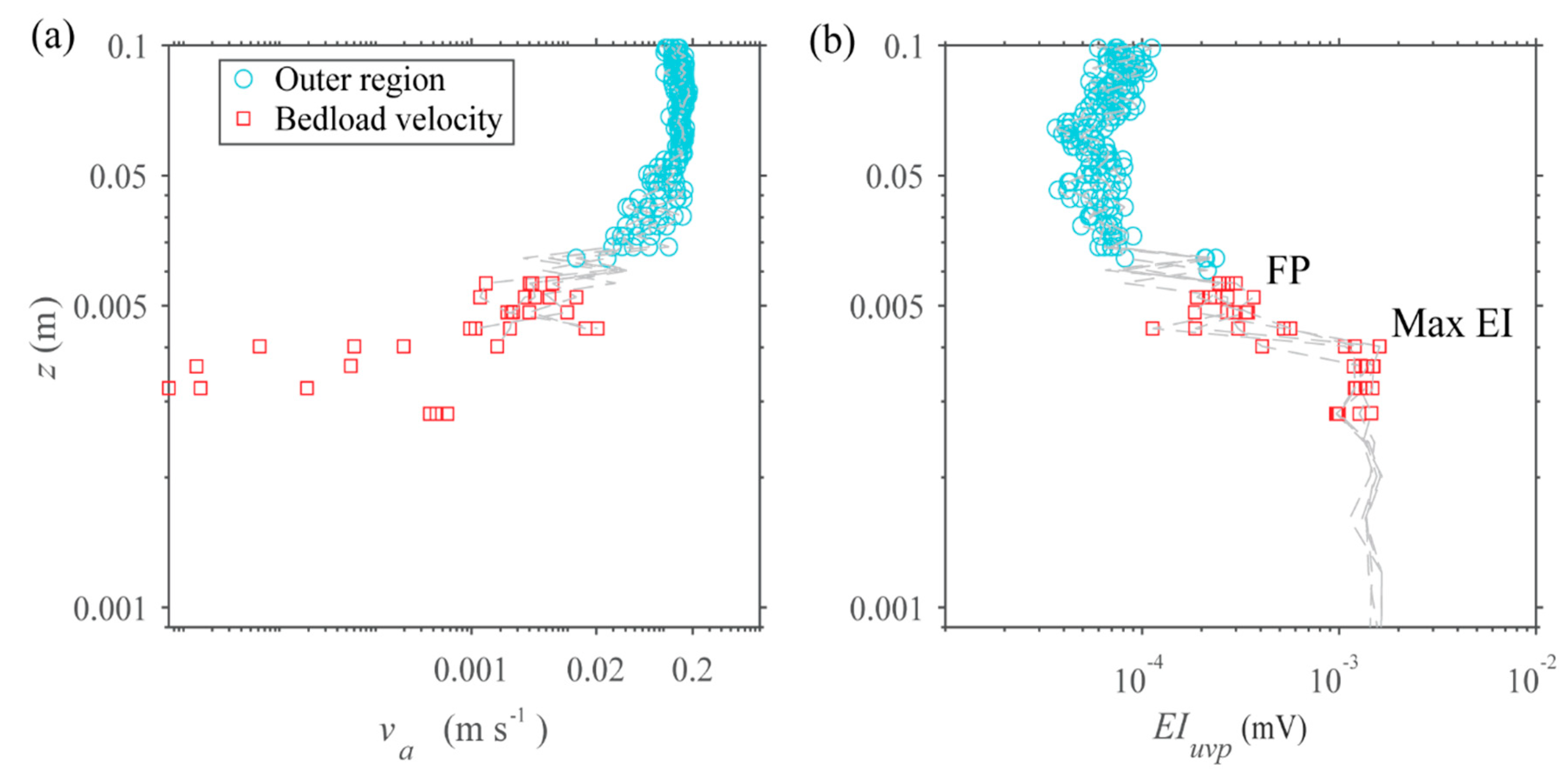

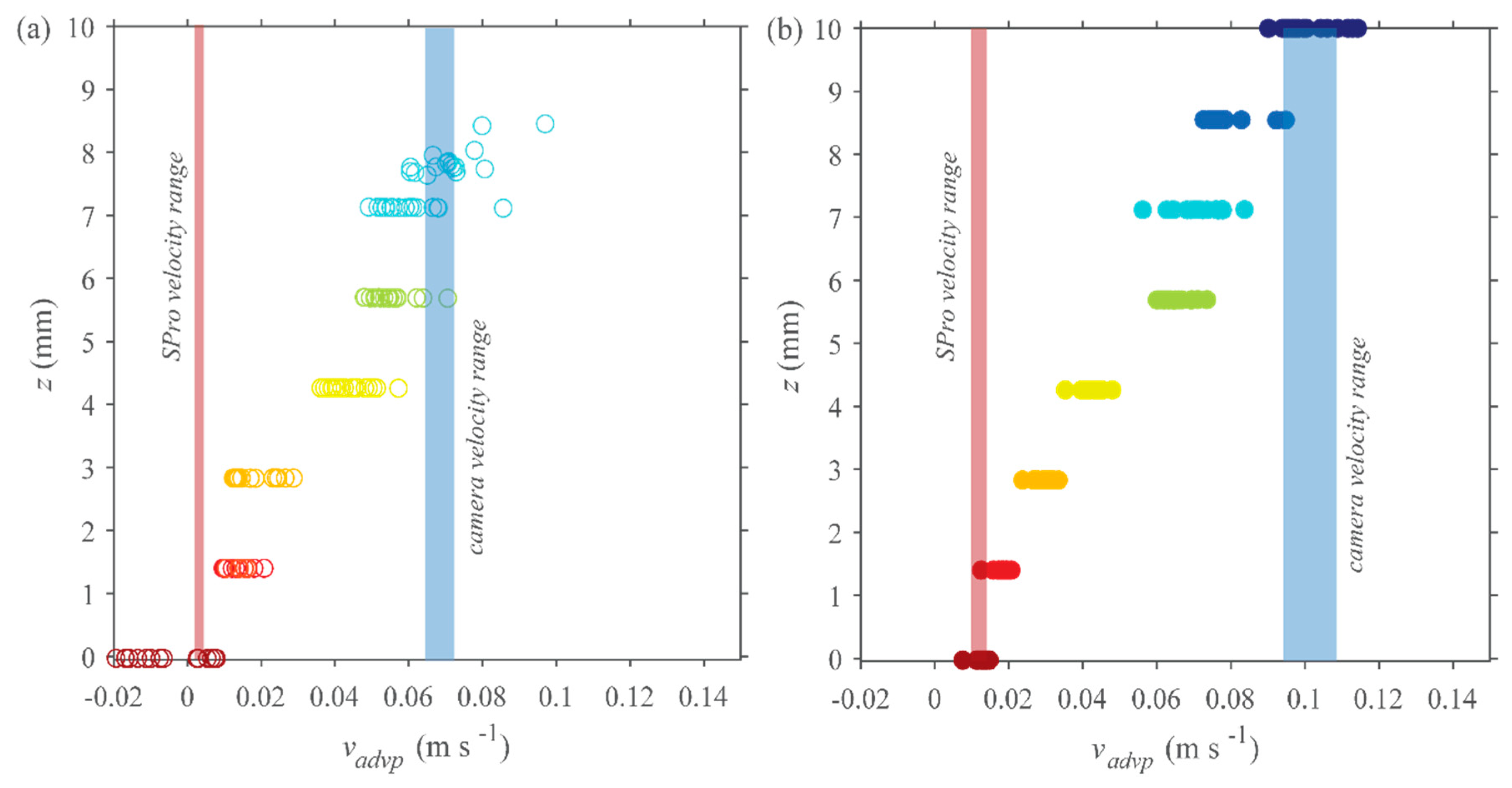
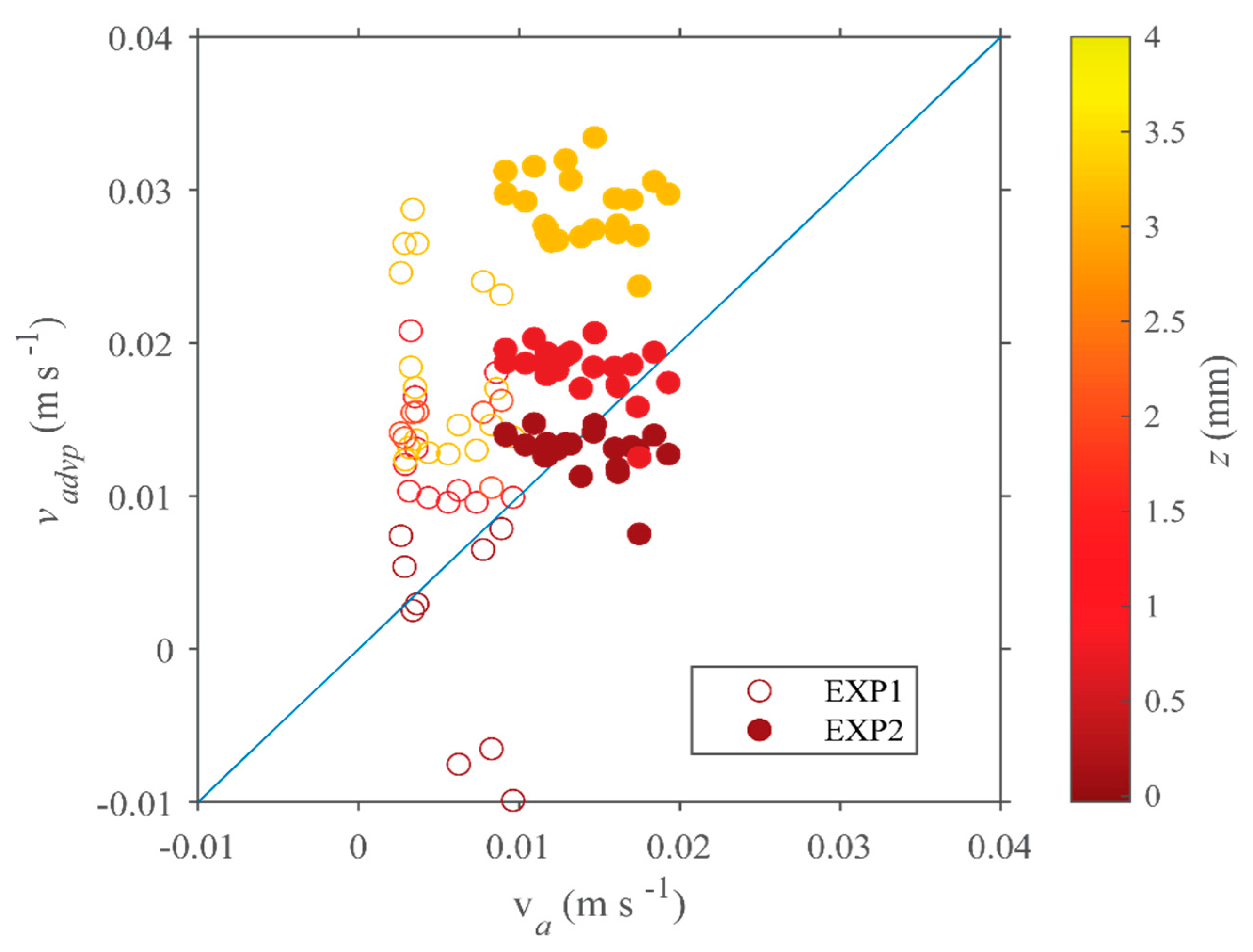
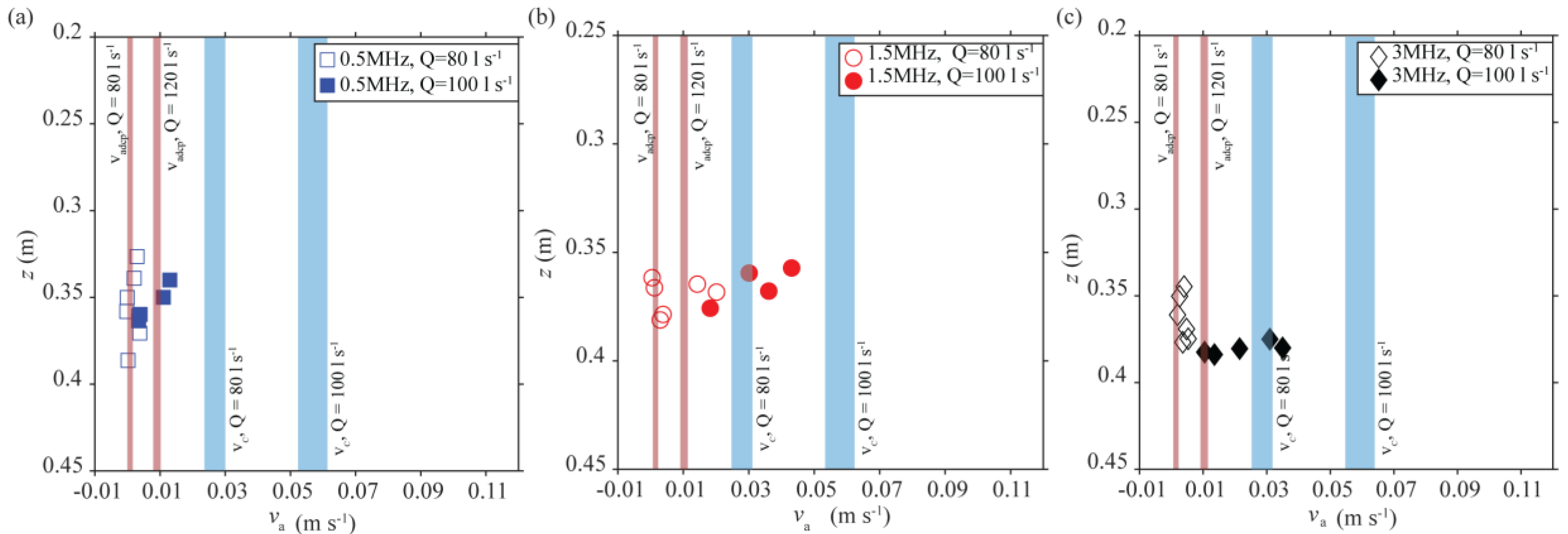
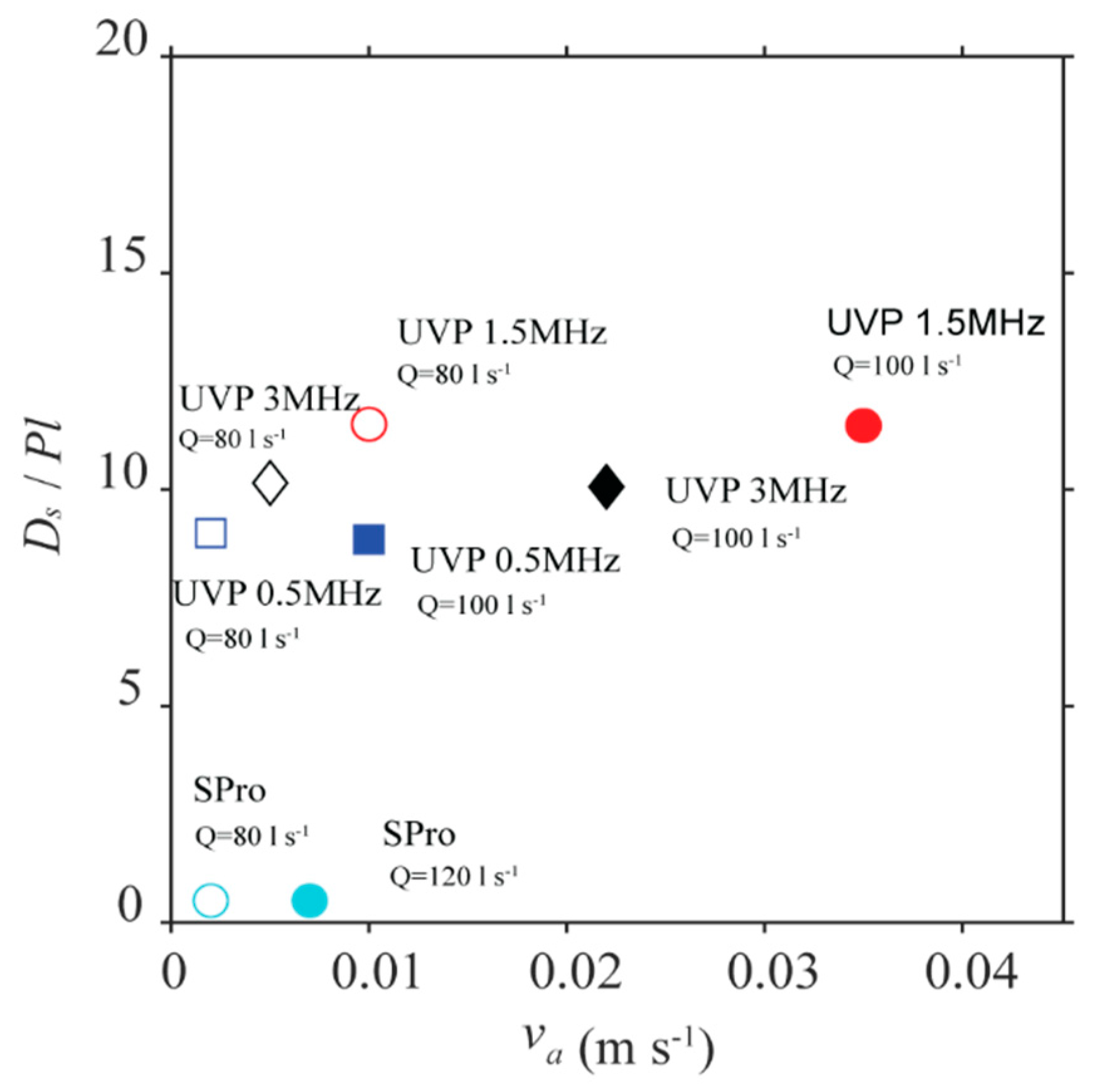
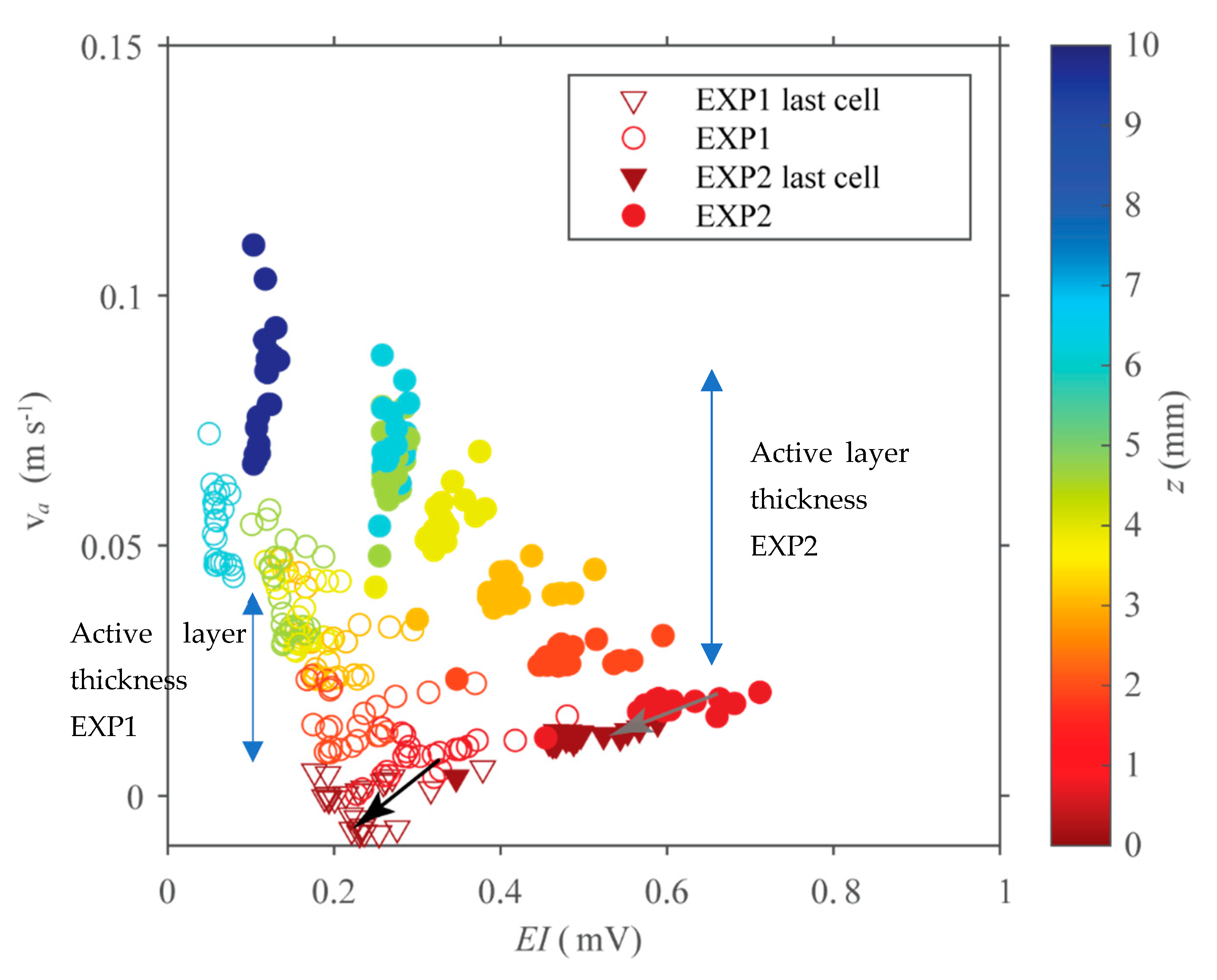
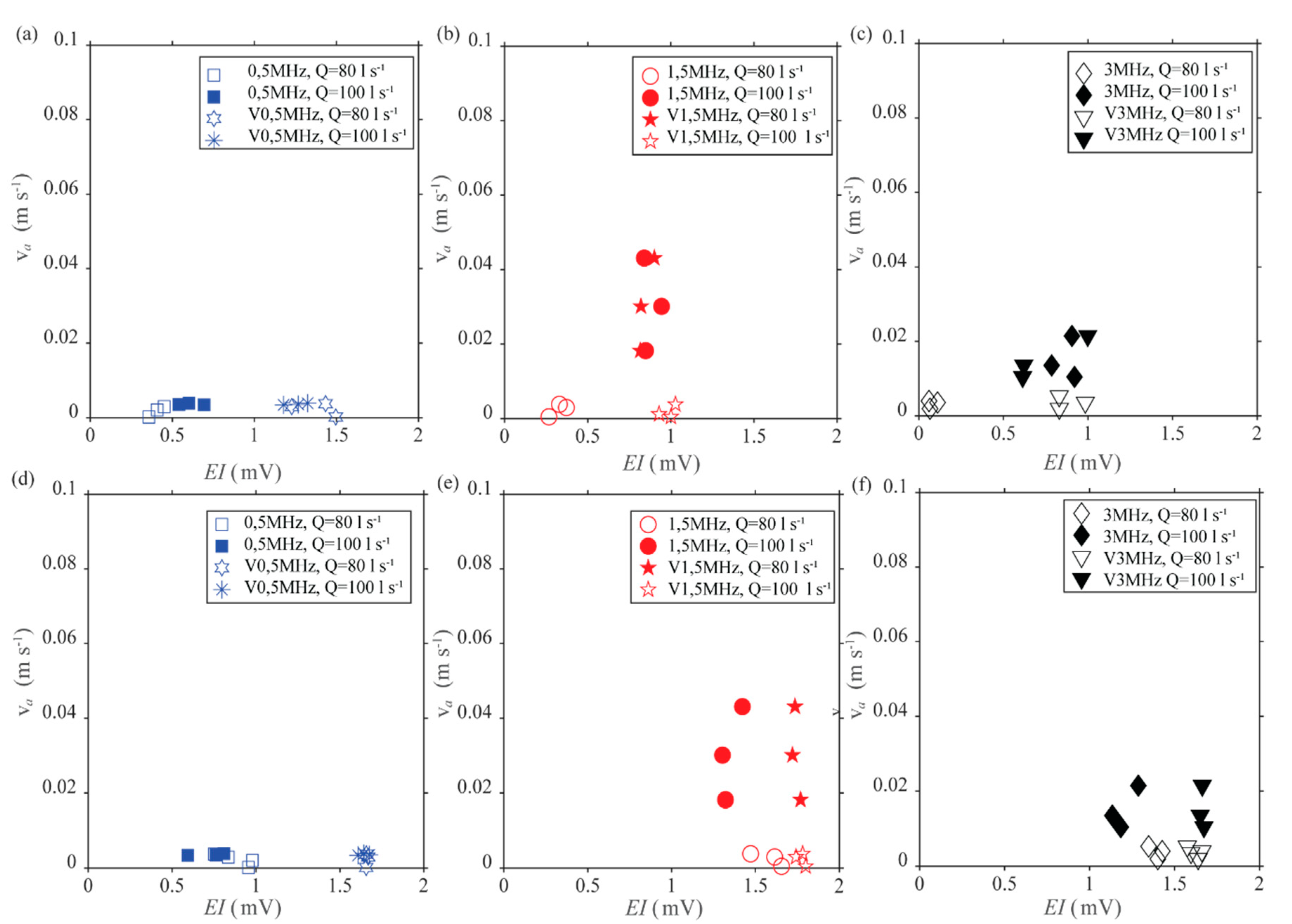
| EXP | Q | H | U | D50 | Rep | ucr* | u* | |
|---|---|---|---|---|---|---|---|---|
| L/s | m | m s−1 | mm | \ | m s−1 | m s−1 | ||
| NTNU | sandEXP1 | 80.00 | 0.40 | 0.3 | 0.35 | 20.00 | 0.014 | 0.015 |
| sandEXP2 | 100.00 | 0.40 | 0.39 | 0.35 | 20.00 | 0.014 | 0.019 | |
| sandEXP22 | 120.00 | 0.40 | 0.43 | 0.35 | 20.00 | 0.014 | 0.021 | |
| UniBo | EXP1 POS1 | 111.68 | 0.31 | 0.45 | 1.00 | 97.00 | 0.021 | 0.023 |
| EXP1 POS2 | 111.48 | 0.31 | 0.41 | 1.00 | 97.00 | 0.021 | 0.025 | |
| EXP2 POS1 | 111.26 | 0.27 | 0.58 | 1.00 | 97.00 | 0.021 | 0.034 | |
| EXP2 POS2 | 110.97 | 0.27 | 0.59 | 1.00 | 97.00 | 0.021 | 0.038 |
| Type | f | Dt | λ | φ | Near Field | θ | Ds | PRF | vmax/Rmax | PL | Cell Size |
|---|---|---|---|---|---|---|---|---|---|---|---|
| MHz | mm | mm | ° | m | ° | mm | m s−1/m | mm | mm | ||
| UVP | 3.0 | 7.0 | 0.5 | 2.0 | 24.8 | 25 | 39 | 1200 | 0.30/0.29 | 4 | 4.4 |
| UVP | 1.5 | 20.0 | 1.0 | 1.4 | 101.4 | 25 | 44 | 1000 | 0.49/0.35 | 4 | 4.4 |
| UVP | 0.5 | 15.0 | 3.0 | 5.7 | 19.0 | 25 | 104 | 900 | 1.33/0.38 | 10.4 | 10.4 |
| UVP | 3.0 | 7.0 | 0.5 | 2.0 | 24.8 | 90 | 7 | 1200 | 0.30/0.29 | 4 | 4.4 |
| UVP | 1.5 | 20.0 | 1.0 | 1.4 | 101.4 | 90 | 20 | 1000 | 0.49/0.35 | 4 | 4.4 |
| UVP | 0.5 | 15.0 | 3.0 | 5.7 | 19.0 | 90 | 15 | 900 | 1.33/0.38 | 10.4 | 10.4 |
| ADVP | 1.0 | 25.0 | 1.5 | 0.0 | / | n.a. | 25 | 500 | 1/0.4 | 1.4 | 1.4 |
| ADCP SPro | 2.0 | 15.0 | 0.7 | 1.3 | 76.0 | 20 | 36 | / | 2/5 | 0.7 | / |
| EXP | SPro | Camera | ADVP | ||||
|---|---|---|---|---|---|---|---|
| Qsm | va | EI | vc | K | va | EI | |
| 35 cm to BED | g s−1 | m s−1 | dB | m s−1 | / | m s−1 | µV × 10−3 |
| EXP1 POS1 | 2.46 | 0.006 | 62.2 | 0.07 | 0.35 | 0.035 | 0.18 |
| EXP1 POS2 | 0.005 | 62.2 | 0.040 | 0.17 | |||
| EXP2 POS1 | 12.63 | 0.014 | 62.5 | 0.11 | 0.55 | 0.055 | 0.41 |
| EXP2 POS2 | 0.014 | 62.3 | 0.058 | 0.45 | |||
| EXP | SPro | Camera | 0.5 MHz | 3 MHz | 1.5 MHz | |||||||
|---|---|---|---|---|---|---|---|---|---|---|---|---|
| Qsm | va | EI | vc | K | dt | va | EI | va | EI | va | EI | |
| 35 cm to BED | g s−1 | m s−1 | dB | m s−1 | / | mm | m s−1 | µV × 10−3 | m s−1 | µV × 10−3 | m s−1 | µV × 10−3 |
| sandEXP1 | 0.00 | 0.002 | 57.9 | 0.02 | 0.06 | 0.53 | 0.002 | 0.45 | 0.005 | 0.11 | 0.01 | 0.39 |
| sandEXP2 | / | / | / | 0.05 | 0.12 | / | 0.010 | 0.65 | 0.022 | 0.93 | 0.035 | 0.91 |
| sandEXP22 | 0.49 | 0.007 | 57.5 | 0.08 | 0.20 | 2.26 | / | / | / | / | / | / |
| ADVP | SPro | |||||||
|---|---|---|---|---|---|---|---|---|
| EXP | va | STDva | repSTDva | va | beforeSTDva | STDva | repSTDva | FD |
| m/s | m/s | m/s | m/s | m/s | m/s | m/s | % | |
| EXP1 POS1 | 0.035 | 0.0400 | 0.0030 | 0.007 | 0.006 | 0.003 | 0.0023 | 49% |
| EXP1 POS2 | 0.04 | 0.0510 | 0.0050 | 0.006 | 0.005 | 0.003 | 0.0025 | 59% |
| EXP2 POS1 | 0.0545 | 0.0480 | 0.0040 | 0.014 | 0.012 | 0.009 | 0.0020 | 43% |
| EXP2 POS2 | 0.058 | 0.0510 | 0.0040 | 0.014 | 0.011 | 0.007 | 0.0031 | 40% |
| EXP | 0.5 MHz | 1.5 MHz | |||||||||
|---|---|---|---|---|---|---|---|---|---|---|---|
| va | before STDva | STDva | repSTDva | FD | va | before STDva | STDva | repSTDva | FD | ||
| m s−1 | m s−1 | m s−1 | m s−1 | % | m s−1 | m s−1 | m s−1 | m s−1 | % | ||
| sandEXP1 | 0.002 | 0.0065 | 0.0054 | 0.0015 | 17% | 0.01 | 0.0514 | 0.0077 | 0.0016 | 9% | |
| sandEXP2 | 0.01 | 0.0306 | 0.0119 | 0.00025 | 21% | 0.035 | 0.0711 | 0.0345 | 0.0124 | 30% | |
| sandEXP22 | / | / | / | / | / | / | / | / | / | / | |
| SPro (2MJHz) | 3 MHz | ||||||||||
| va | before STDva | STDva | repSTDva | FD | va | before STDva | STDva | repSTDva | FD | ||
| m s−1 | m s−1 | m s−1 | m s−1 | % | m s−1 | m s−1 | m s−1 | m s−1 | % | ||
| sandEXP1 | 0.002 | 0.001 | 0.0004 | 0.0001 | 80% | 0.005 | 0.0409 | 0.0067 | 0.0014 | 19% | |
| sandEXP2 | / | / | / | / | / | 0.022 | 0.054 | 0.011 | 0.0042 | 28% | |
| sandEXP22 | 0.007 | 0.005 | 0.0040 | 0.0010 | 43% | / | / | / | / | / | |
Publisher’s Note: MDPI stays neutral with regard to jurisdictional claims in published maps and institutional affiliations. |
© 2020 by the authors. Licensee MDPI, Basel, Switzerland. This article is an open access article distributed under the terms and conditions of the Creative Commons Attribution (CC BY) license (http://creativecommons.org/licenses/by/4.0/).
Share and Cite
Conevski, S.; Aleixo, R.; Guerrero, M.; Ruther, N. Bedload Velocity and Backscattering Strength from Mobile Sediment Bed: A Laboratory Investigation Comparing Bistatic Versus Monostatic Acoustic Configuration. Water 2020, 12, 3318. https://doi.org/10.3390/w12123318
Conevski S, Aleixo R, Guerrero M, Ruther N. Bedload Velocity and Backscattering Strength from Mobile Sediment Bed: A Laboratory Investigation Comparing Bistatic Versus Monostatic Acoustic Configuration. Water. 2020; 12(12):3318. https://doi.org/10.3390/w12123318
Chicago/Turabian StyleConevski, Slaven, Rui Aleixo, Massimo Guerrero, and Nils Ruther. 2020. "Bedload Velocity and Backscattering Strength from Mobile Sediment Bed: A Laboratory Investigation Comparing Bistatic Versus Monostatic Acoustic Configuration" Water 12, no. 12: 3318. https://doi.org/10.3390/w12123318
APA StyleConevski, S., Aleixo, R., Guerrero, M., & Ruther, N. (2020). Bedload Velocity and Backscattering Strength from Mobile Sediment Bed: A Laboratory Investigation Comparing Bistatic Versus Monostatic Acoustic Configuration. Water, 12(12), 3318. https://doi.org/10.3390/w12123318







